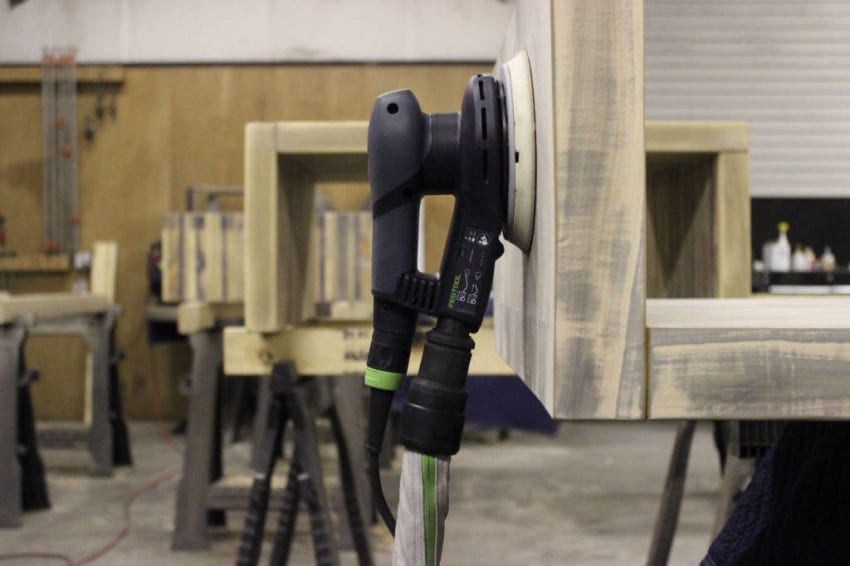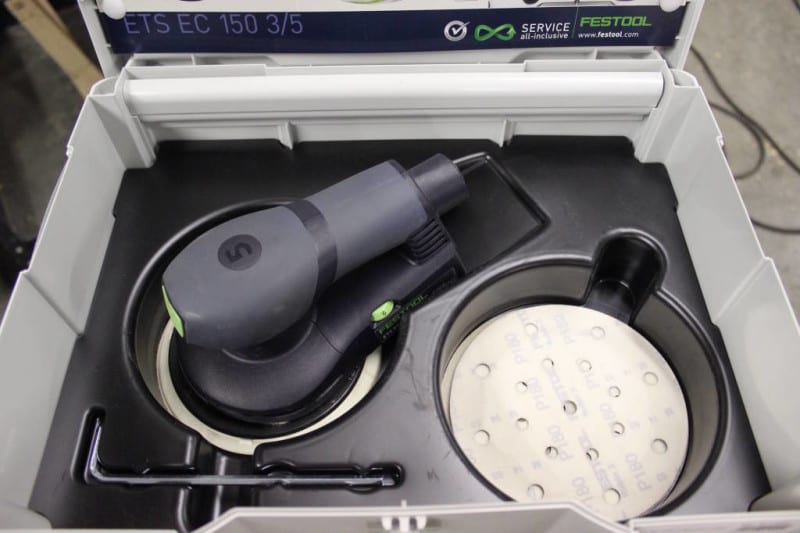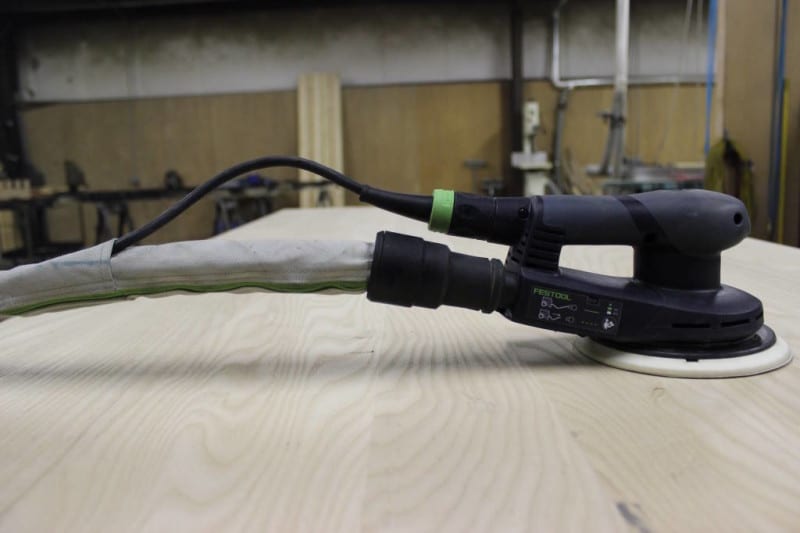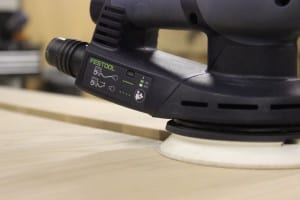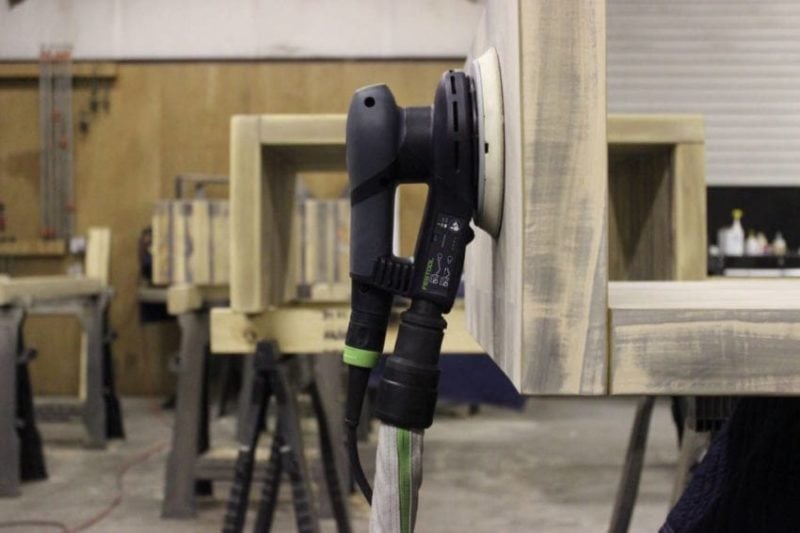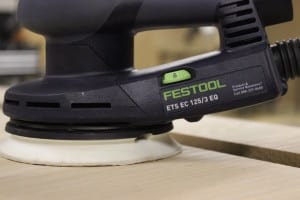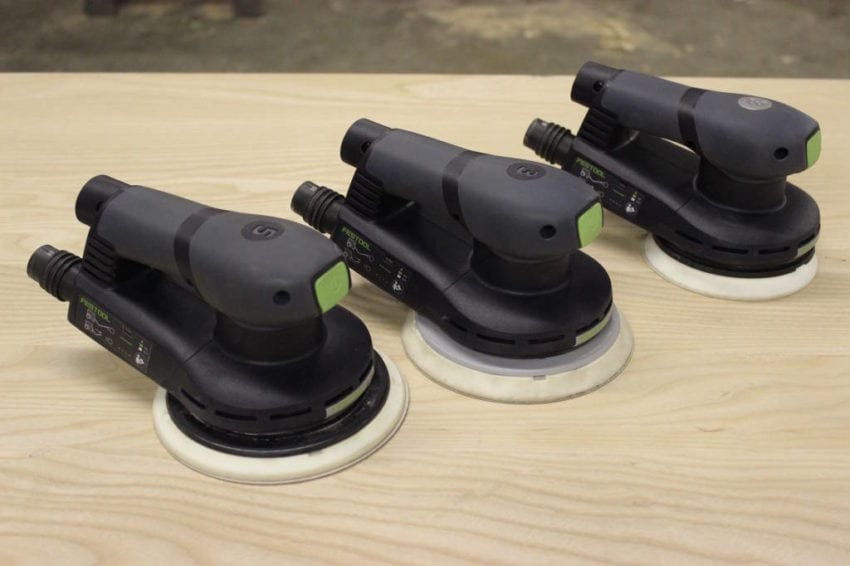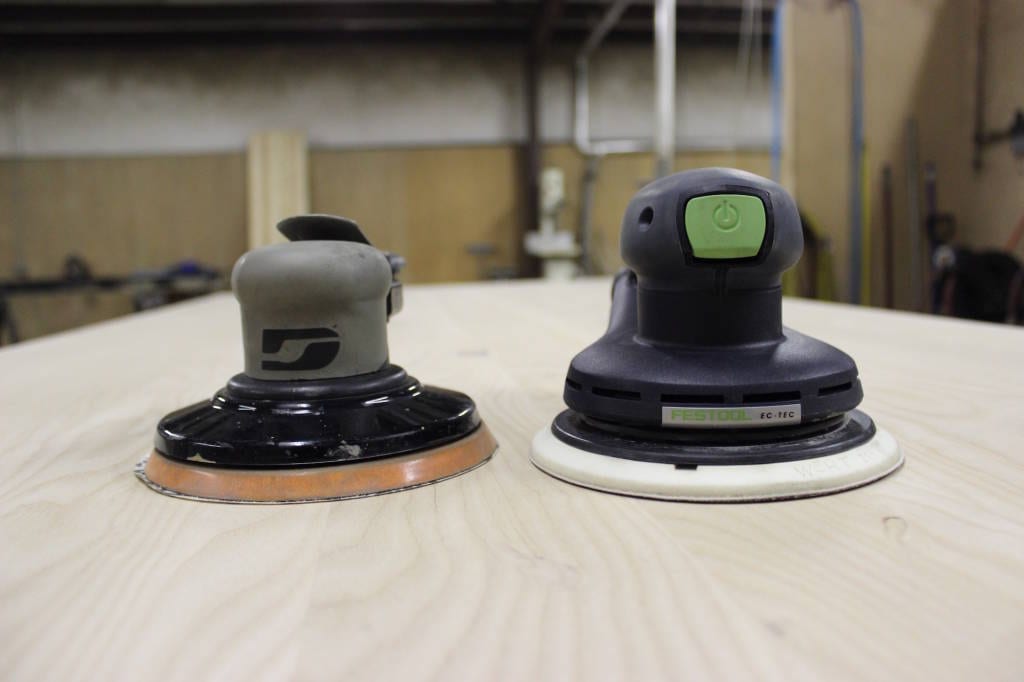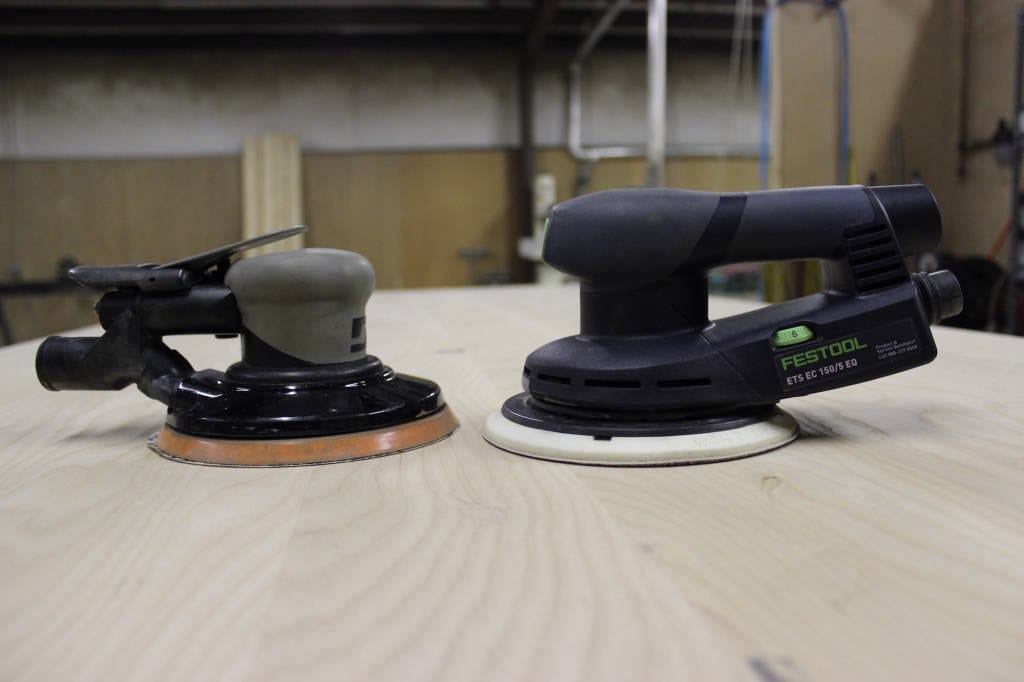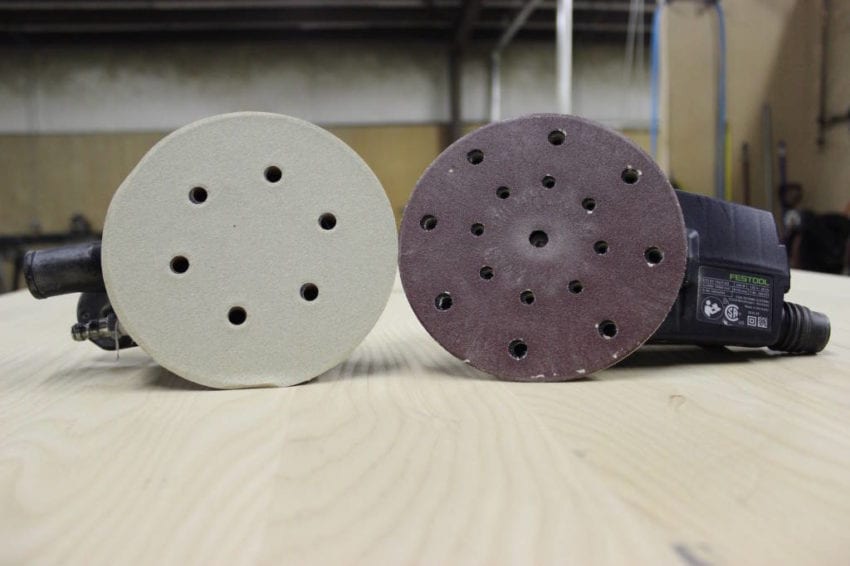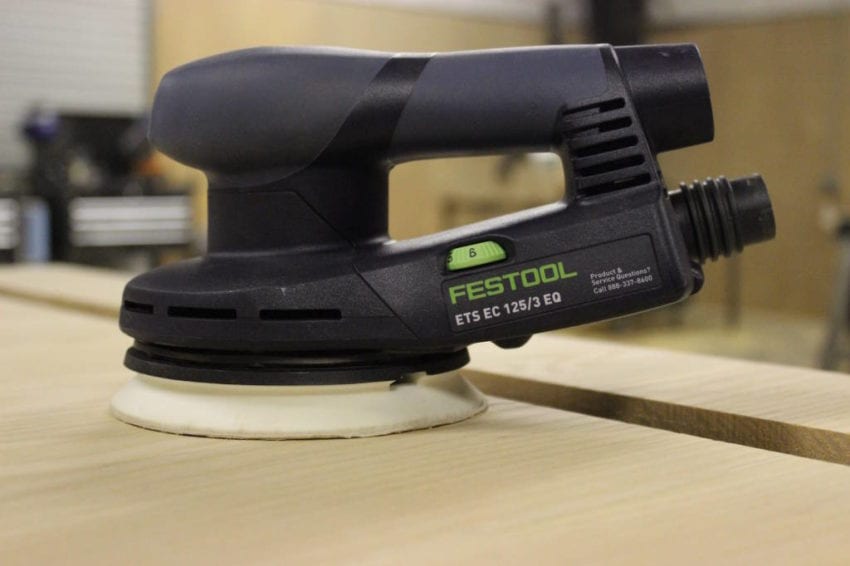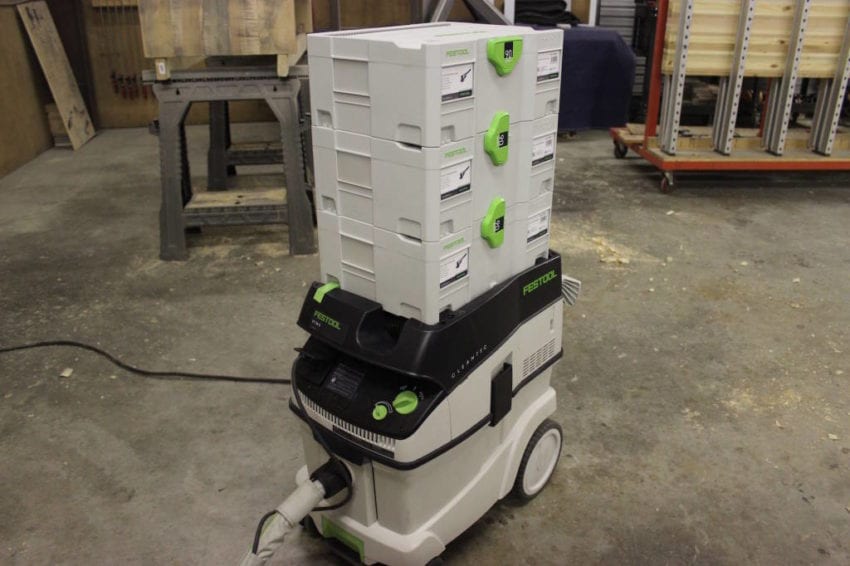Sanding was one of those woodworking steps that always seemed an easy part of the finishing process… that is, until I started selling my pieces professionally and looking more closely at the detail in my finished product. I had no idea how difficult it was to achieve a smooth, flat, consistent, swirl-free finish on a massive solid wood tabletop without having access to industrial wide-belt sanding machinery. I’ve used everything from belt sanders to random orbit sanders, sheet sanders, inline sanders, and pneumatic random orbit sanders.
After burning up a few electric motors and navigating my way through the sea of abrasive options, I’d settled on Dynabrade pneumatic random orbit sanders, Klingspor abrasives, and my Festool CT 36 HEPA dust extractor for tooling. I’m fortunate enough to have a 120-gallon compressor that puts out about 40 cfm at 90 psi, so although pneumatic sanders do have their short list of woodworking drawbacks, sufficient air supply to run a couple of sanders at a time was not a hurdle for me.
When Clint DeBoer returned from his trip to Germany, having toured the Festool factories, he was pretty excited to tell me about their Festool ETS EC Brushless Sanders. After reading the afore-linked article and hearing the claims from Festool (“performance of an air sander”), I was definitely interested in doing a real-world comparison with my pneumatic setup. I also did some reading up on the Festool LEX 3 pneumatic setup (found only on their international site), so I plan to get into how Festool answers some of the drawbacks to pneumatic sanding as well while I work through integrating Festool LEX 3 Sanders and a CT Dust Extractor Conversion (sorting through the parts and options)
Festool ETS EC Brushless Sanders Models and Specifications
| Model | ETS EC 150/3 | ETS EC 150/5 |
| Power consumption | 400 W | 400 W |
| Eccentric motion speed | 6000 – 10000 | 6000 – 10000 |
| Interchangeable sanding pad diameter | 150 mm (6’’) | 150 mm (6’’) |
| No. of strokes | 3 mm (1/8’’) | 5 mm (3/16’’) |
| Pad | FUSION-TEC SW (super-soft) | FUSION-TEC W-HT (soft-HT) |
| Motor | EC-TEC motor | EC-TEC motor |
| Connection Ø d/e | 27 mm | 27 mm |
| Height (incl. pad) | 116 mm | 113 mm |
| Weight | 1.2 kg / 2.65 lbs. | 1.2 kg /2.65 lbs. |
| Price | $485 | $485 |
Festool ETS EC Brushless Sanders Out of the Box
If you’ve read any of my previous reviews, you know I’m a fan of hard cases. I feel the industry has stepped backward with soft canvas bags, but Festool is a definite step forward in this area. Festool power tools come in hard case-meets-toolbox “Systainers” which not only attach to your CT Dust Extractor or Systainer Carts but also their other sorting/storage containers called… wait for it… “Sortainers”. This system and cross-tool connectivity approach are one of the many benefits of acquiring a shop full of Festool. I give them an absolute A+ for packaging and storage.
Picking up Festool ETS EC Brushless Sanders for the first time, you definitely feel the quality. The handle is very comfortable and more versatile than my Dynabrade and the weight feels very balanced. Although the Festool ETS EC Brushless Sander is heavier than my Dynabrade and slightly taller, it’s about half the weight of my DeWalt 5” & Bosch 6” electric random orbit sanders and the profile is way over on the pneumatic side. I also get to plug in Festool’s new sleeved hose with the integrated power cord. This will prevent the edges of your workpiece from snagging the standard ribbed hose.
I Know You’re Excited, But Try to Systainer Yourself…
With my Dynabrade pneumatic sander, I used my CT 36 manually, meaning I had to turn the dust extractor on and off every time I started/stopped sanding. I know it’s not difficult to turn the switch back and forth and I’m not complaining about the effort involved, but many times I’d shut it off to switch sanding discs and forget to turn the dust extractor back on again without noticing for a few minutes. That’s enough time to get dust all over your workpiece and a decent coating of dust in your schnoz. All this to say, the auto on/off feature is awesome and now I can use it! Speaking of automatically communicating with your extractor, the Festool ETS EC Brushless Sanders have a pretty cool feature that lets you set the sanders to only work when an extractor is connected, making sure you don’t accidentally coat the inside of your nose and everyone else’s with dust. I activated this feature on each of the sanders and it works flawlessly.
Sanding and More Sanding
One of the first pieces I sanded with the Festool ETS EC Brushless Sanders was a solid maple coffee table. I instantly felt a difference in the vacuum force. Festool claims an innovative Multi-Jetstream dust extraction feature. I was so taken aback by the vacuum force that I turned the extractor on manually, stuck the Festool ETS EC 150/5 directly on the vertical side of the coffee table and slowly moved my hands away (after, of course, putting a wadded up moving blanket underneath my $485 tool) and… it stuck! The CT 36 bag was ¾ full to boot! I tested every other sander in my shop and had nowhere near the suction.
I’ve had the Festool ETS EC Brushless Sanders in my shop now for about a month and I can attest, they are as smooth as my Dynabrade sanders. The electronic vibration control makes a world of difference. I could spend an entire day working with the ETS EC’s and experience no numbness in my hands and no more fatigue than typical with pneumatics. They’re also easy on the ears: I don’t think they are any louder than my Dynabrade and they’re definitely less “whiny”. The weight difference doesn’t bother me on horizontal surfaces, though it’s noticeable on vertical surfaces. When rounding/softening corners, I prefer the lightweight Dynabrade with the variable speed paddle (more on that later). The ETS EC sanders also deliver very consistent power, even under pressure. You can definitely bog down a pneumatic sander before you can bog down the Festool brushless sander.
Standout Features
There was one unexpected feature that didn’t initially strike me but turned out to be something I really appreciated: the pad brake. The sanding pad on the Festool ETS EC Brushless Sanders comes to a shockingly sudden halt as soon as you power off – you can set the sander back down on your workpiece right away without putting patterned scratches back in the wood. With the Dynabrade, the pad spins out for a while unless you manually stop it with your palm or your jeans. If you set the Dynabrade back down on your wood surface before it comes to a complete stop, you’ll be sanding out a few half-moon scratches before you’re done.
One feature missing, when compared with the Dynabrade, is the variable speed paddle. I think this feature is exclusive to pneumatics, but it’s one I’ve grown accustomed to without realizing it. It’s second nature to me now to lift my hand a bit to slow down the Dynabrade speed when softening a corner or touching up a spot here or there. The Festool ETS EC Brushless Sanders do indeed have a variable speed adjustment, but you have to turn the dial down. I honestly don’t think an electronic variable speed paddle switch is feasible, nor would it function quite like a pneumatic lever, but it’s worth mentioning.
Final Thoughts
If you are in the market for new sanding equipment, I definitely recommend Festool. Using Festool ETS EC Brushless Sanders with my Festool CT 36 really brought out the features of both tools and highlighted how they function as a system to yield a superior finish. When it comes to which system to choose (air or electric), go electric and go brushless if you don’t already have a massive compressor or if you’re looking for a job site sander. The Festool ETS EC Brushless Sanders are easily in league with pneumatic sanders—even better than some I’ve tried. They also land on par with my favorites—definitely the closest feel to a pneumatic of any electric sander I’ve used. If you already own some serious air, stay tuned for when we compare Festool’s LEX 3 Air Sanders to their ETS EC Brushless Sanders.

